A guest walks through the colorful Venetian Room before entering the Mansbach White Salon. Even though the contrast seems extraordinarily large, there are similarities.
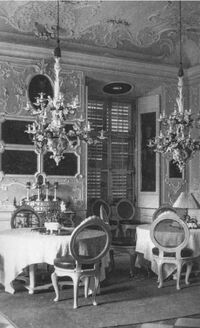
In the era of the theater genius Max Reinhardt, this was an elegant family meeting place. The Mansbach White Salon housed the porcelain collection with tableware and candle chandeliers from Meissen, but also valuable glasses that added a glamorous touch to every meal.
“May I now fulfil my pleasant duty and remind you that the table is set in the White Room? It is (…) genuine damask, genuine Bohemian crystal, genuine hand-painted porcelain, Vieux Saxe design, genuine silver and the coat of arms is also genuine(…)”
“In the ‘White Room’, the private dining room, the paintings in light stucco shone on the walls and the guests had lunch …”
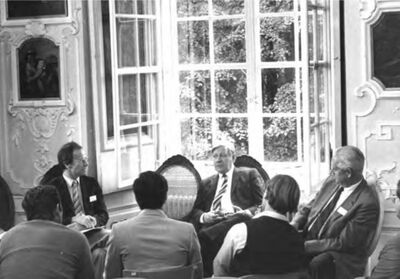
From the 1950s onwards, the Dexter Perkins Room, named after the first president of the Salzburg Seminar, was used for high-level discussion groups and later also as a canteen for staff, conveniently located next to the kitchen. Since the palace has been transformed into a hotel, it once again exudes cultivated charm for small informal meals.
A comparison shows this room to be strikingly kindred to the Venetian Room: the original tiled stove from around 1740 in blue with gold ornamentation is almost identical to the somewhat more opulent stove in the Venetian Room, the former music room. While the latter glows with lush colors and exuberant decoration, the Mansbach White Salon’s stove blends effortlessly into the room’s delicate color scheme.
The extremely sculptural ceiling stucco, also from the time when the palace was built, rightly delights the observer with its nearly overflowing flower bouquets and the strong scrollwork.
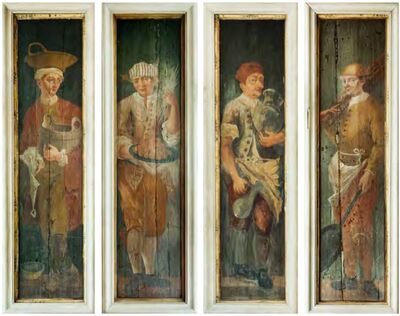
The walls, however, bear a different signature. Max Reinhardt’s designs were implemented in the 1920s by his stucco specialists of the Strasser company. They serve as opulent framings for numerous portraits, mainly of the Firmian family. However, before Reinhardt was able to acquire the Venetian wall panels in 1929, thus giving the music room its incomparable charisma, it was also fitted with stucco frames of the same kind for his growing commedia dell’arte collection.
Here as well as there one finds flower paintings by Gusti Adler’s sister, the artist and restorer Marianne Adler (1888–1952).
The unusual wooden window sashes, which are exclusive to this room, are painted with depictions of cooks and cupbearers. The fact that they are somewhat too narrow for the projecting windows shows that they originally came from a palace in Lower Austria.
The hardwood floor is covered in the middle with a carpet, only the edges are covered with stone diamonds.
The Mansbach White Salon is named after B. Thomas Mansbach, a Senior Fellow who has provided support to upgrade and renovate the room. The room has been renamed to recognize his contribution.
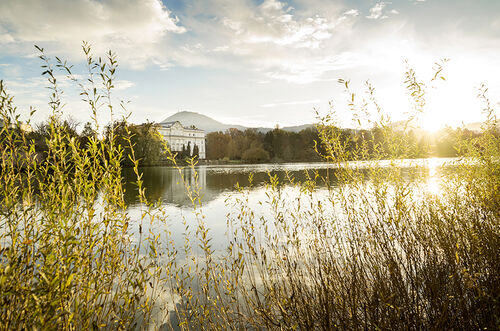
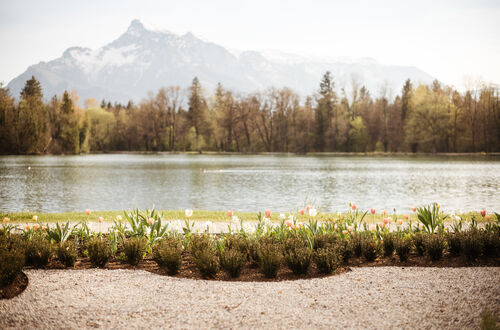
Sustainable, Ambitious, Visionary: Salzburg Global’s Sustainability Efforts
Stewardship of Schloss Leopoldskron requires ensuring its longevity and sustainability for decades and even centuries to come—both financially and environmentally.
Hotel Schloss Leopoldskron has been part of The Climate Alliance, Austria’s largest climate protection network, since 2014. Changes big and small have since been made, from changing the heating supply of the Schloss to central district heating—which required the removal of old oil tanks from the cellar and digging up the Schloss lawn—to switching food, beverage and cosmetics suppliers to more local, organic and ethical companies. Energy efficiency and climate-friendly measures remain at the forefront for any future renovation and remodeling projects—and there are many in the masterplan pipeline.
In 2019, Salzburg Global commissioned global design and architecture firm Gensler to devise a long-term strategy plan for Schloss Leopoldskron, the Meierhof and its 17-acres of grounds. The ambitious plan is of course guided by the vision to ensure Salzburg Global’s mission—to challenge current and future leaders to shape a better world—is always at the core of facilities planning, with the intention to integrate historic character, breath-taking beauty, and state-of-the-art technology to create conditions of trust and openness that enhance global exchange and collaboration. The renovations will be realized in multiple phases over the coming decades (as fundraising allows) with these plans being touted as the organization’s most ambitious yet. As well as another significant remodeling of the Meierhof—the fifth in as
many decades—renovations are proposed for every level of the Schloss—from the cellar to the attic.
With the appointment of a new President in 2022, Salzburg Global also has ambitions plans to make greatest use of existing and possible-new spaces, such as developing new multi-year program series, attracting more hotel guests, corporate clients and film shootings, engaging more local partners, and co-creating large events in the Schloss and Park –firmly placing Schloss Leopoldskron on the map and renewing its cultural importance in the heart of Europe.
